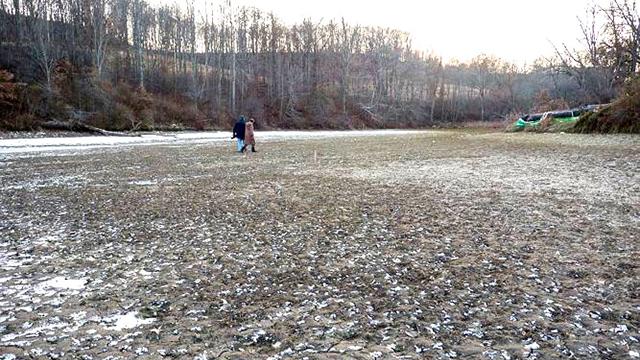
A tiny town in eastern Ohio is being sued by an Oklahoma-based oil and gas company that bought more than 180 million gallons of water from the town last year. That water use, combined with a dry fall, prompted the village to temporarily shut off water to Gulfport Energy. Now, a second company has a water agreement, and there might not be enough water to go around.
Gulfport Energy alleges in the lawsuit that the village of Barnesville, population 4,100, violated its agreement to provide water from its reservoir by entering into a contract with oil and gas company Antero Resources. Gulfport says the village’s contract with Antero allows for withdrawals beyond what Gulfport is allowed to take.
Gulfport’s water supply can be shut off whenever water levels in the reservoir create a risk to the health and safety of the village residents and businesses. Last fall, the reservoir was down three feet below average when village officials stopped all outside withdrawals.
“We felt like we had to shut everyone off to protect the regular users,” said village solicitor Marlin Harper. “We don’t have unlimited water.”
But here’s the catch: Only Gulfport pumped water out of the reservoir last year. So even though, as Harper admits, the Antero contract has “a little bit of a priority” over the Gulfport contract, that’s not the reason Gulfport’s water supply was shut off. During the unusually dry fall, water withdrawals by Gulfport alone were too much for the reservoir to sustain.
Environmentalists stress how valuable water is in the area, and particularly how valuable the reservoir at the heart of the lawsuit is. The water being sold to Gulfport comes from the Slope Creek Reservoir, which supplies water to all the town’s residents as well as another 8,000 people in neighboring areas, said John Morgan, a spokesman for Concerned Barnesville Area Residents.
“It’s one of the best reservoirs in the area,” Morgan told ThinkProgress. “North of us, everything was strip mined years ago, so having a good water supply is valuable here.” When the reservoir got low last year, residents got alarmed, he said.
Concerns over water supplies make sense in Ohio, a state that has steadily increased the number of drilling permits it has issued over the years. In 2010, Ohio issued 651 drilling permits. In 2013, the last year the state provides data on, it issued 1,000 drilling permits.
In Belmont County, where Barnesville is located, 63 horizontal drilling permits were issued in 2013. Belmont and its neighboring eastern Ohio counties have the most active oil and gas development in the state, according to documents from the state’s Division of Oil and Gas Resource Management. By 2019, there will be an estimated 3,240 horizontal oil and gas wells in Ohio, according to Iryna Lendel, assistant director of the Center for Economic Development at Cleveland State University.
But critics of Ohio’s oil and gas boom have worried that there isn’t enough regulation on either the drilling or the subsequent disposal of waste water. During the hydraulic fracturing process, known as fracking, water mixed with sand and chemicals is ejected into underground layers of rock, freeing tiny pockets of oil or natural gas. The wastewater often can’t be reused, is filled with chemicals, and can sometimes be contaminated with naturally occurring radiation from the shale.
“Once it’s been used, it is polluted,” Morgan said. “Other states have been realizing their need to catch up and regulate better. Ohio has been going the other direction and deregulating.”
The risks from fracking are myriad. Twenty-five families about 50 miles south of Barnesville were evacuated last year after a fracking well sprung a leak. Fracking in Ohio has triggered earthquakes, and there is concern about how waste water is treated and stored. A study in the Akron Beacon Journal found that one drilling well can have nearly 1 million pounds of liquid chemical additives.
Gulfport claims that if Barnesville fails to provide water, Gulfport could lose millions of dollars. The company pays more than $75,000 a year for water, it said in court documents.
Protecting water rights against the interests of the gas and oil industry in Ohio is a struggle, Morgan said. His group, Concerned Barnesville Area Residents, formed around the issues of potential water pollution from oil and gas extraction in the area.
The state Environmental Protection Agency (EPA) has been developing a Source Water Assessment and Protection Program, but the agency has limited oversight. All regulation of oil and gas extraction falls under the Division of Oil and Gas Resource Management.
“The EPA is trying to help up with the source water protection plan, but they can’t directly have any say about oil and gas wells,” Morgan said.
Other avenues for protecting water have also been blocked. Last month, the Ohio Supreme Court ruled that towns can’t ban fracking through local zoning laws.
For now, water withdrawals continue at the reservoir, and there is enough for everyone. But locals expect that Antero will start up operations this year, which will mean two companies taking water from the reservoir. Another dry summer could mean another mandatory shut off and another round of litigation for Barnesville.
3 WAYS TO SHOW YOUR SUPPORT
- Log in to post comments











